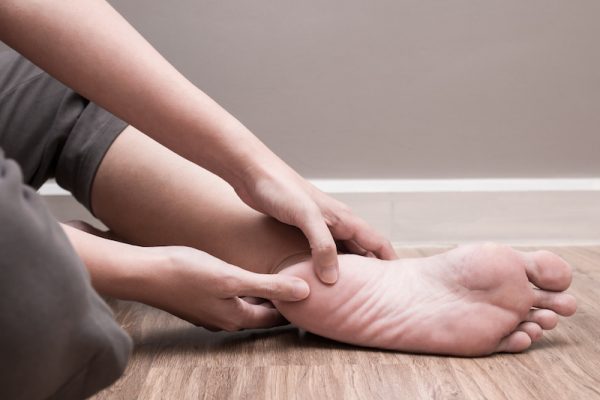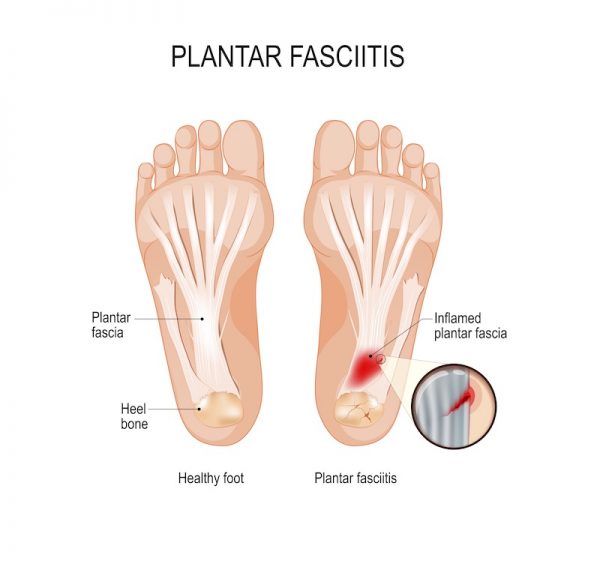You crawl under the covers at night and your heel feels fine. You wake up and can hardly walk because it hurts so much. After a few minutes, the pain is gone. It’s become part of your morning routine. What’s the problem? It could be heel pain syndrome or plantar fasciitis.
Dr. Michael Saraydarian, a Maine podiatrist, says plantar fasciitis is the most common condition he and other general foot and ankle doctors see.
What causes it and how can it be prevented or treated? Dr. Saraydarian gives us some answers. First, a quick anatomy lesson. The plantar fascia is a thick band of tissue on the bottom of the foot. It connects the heel to the toes and supports the arch.
What causes plantar fasciitis?
When you have fasciitis, it means the band of tissue is irritated or inflamed. Dr. Saraydarian says repetitively overusing and overstretching the fascia and wearing shoes that don’t fit the activity you’re doing are the most common causes.
For instance, if I took pretty much the general public and put them barefoot or in flip flops and had them hike up and down mount Mount Katahdin, they likely would come in with plantar fasciitis.
What are common symptoms?
There is pain on the bottom of the heel, generally about a three-finger distance from the back of the heel in a very classic spot. People usually have pain in the morning when they wake up with the first step. It kind of subsides after about a half hour or even minutes of bearing weight. It might come back after being on your feet for a period of time. There’s often no visible inflammation — it’s usually deep down inflammation. Most patients won’t have a history of trauma or an aha moment when it comes to onset. It usually comes in a gradual manner.
Will I need surgery to make it go away?
Surgery is very, very rare when it comes to plantar fasciitis. Statistics show that less than five percent of people need surgery. I follow a treatment plan that the American College of Foot and Ankle Surgeons put forth in 2010. Basically, it’s a mix of getting rid of the inflammation, not aggravating it by wearing certain structured shoes or immobilizing the foot, and doing some stretching. Usually, 95 percent of patients are better within weeks.
How can I prevent heel pain and plantar fasciitis?
Step one, make sure you don’t aggravate the structures of your foot, which means wear the right shoe for the activity. If you’re going hiking, wear a hiking shoe. If you’re going to run, wear a running shoe. The reason we have all these different types of shoes is because they each serve a purpose for the particular activity. If you’re not sure, I usually suggest cross trainer type shoes which are a mix of all of the qualities that are required.
Step two, prepare for particular activities with some simple stretching. One of the simplest things would be to roll your foot on a tennis ball. That will stretch out all of the structures on the bottom of the foot, including the fascia and the muscles and the other structures to get ready for the particular activity. Then do a simple posterior stretch.
I usually suggest standing stand on a step with the back half of the foot off the step. Lock the knees, tighten the buttocks and drop the heels down. That stretch will actually reach from the gluteus all the way down to the heel. Hold for 10 seconds and do it 10 times. It’s not a huge time investment and it can be done easily with any step or stair. I actually do it periodically throughout the day. I like to do it even when I’m teaching patients how to do it.
Dr. Saraydarian’s biggest piece of advice is to take care of your feet before something happens.
The unfortunate part is that a problem doesn’t tend to just go away because we’re constantly walking on our feet. Once you get something it tends to linger because the foot is constantly under demand.



I have tried almost everything to minimize Plantar Fasciitis which I have been encountering for 4 years. But one of the most effective ways is stretching. I do stretch everyday and it works.
Thanks for the helpful article.
My heel hurts before I even get out of need and put weight on it. Its woken me up many times in the past couple of weeks. Is this a symptom of plantar fasciitus?